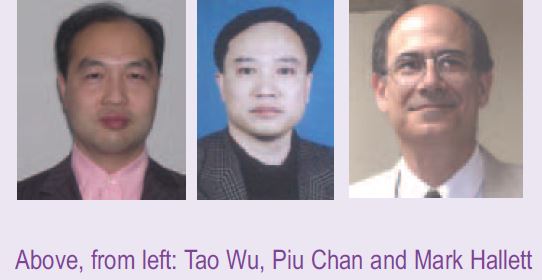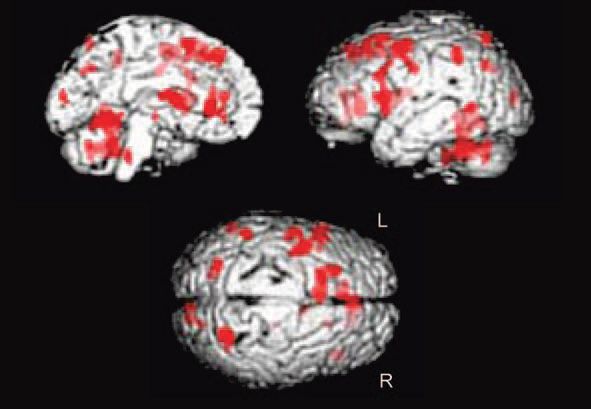
Physiology News Magazine
Ageing influence on automatic movement
Tao Wu and colleagues focus on the understanding of motor control in normal and disorder conditions
Features
Ageing influence on automatic movement
Tao Wu and colleagues focus on the understanding of motor control in normal and disorder conditions
Features
Tao Wu (1,2), Piu Chan (2), & Mark Hallett (1)
1: Human Motor Control Section, Medical Neurology Branch, National Institute of Neurological Disorders and Stroke, National Institutes of Health, Bethesda, Maryland, USA
2: Beijing Institute of Geriatrics, Department of Neurology, Xuanwu Hospital, Capital University of Medical Sciences, Beijing, People’s Republic of China
https://doi.org/10.36866/pn.59.30

Understanding ageing influence on human life remains a challenge. There is a series of changes during ageing, such as cell loss, synaptic degeneration, blood flow reduction and neurochemical alteration. Normal ageing is not only characterised by a decline of memory, perception and cognition, but also accompanied by progressive slowness and impaired motor ability. In recent years, functional neuroimaging techniques, like PET and functional MRI (fMRI), have been employed to compare brain activation in aged and young adults in performing memory, cognitive and motor tasks. Due to different paradigms used, and the different performance level aged subjects achieved, some results have been inconsistent. Most studies have focused on simple motor tasks, like finger tapping, and found that ageing subjects need greater activity and recruit additional brain regions for execution of certain tasks at the same level as young subjects. However, the influence of ageing on more complex motor behaviours has been only rarely studied. Actually, there is evidence which implies that normal ageing may have different effects on brain activity when performing various motor tasks.
In our recent work we used fMRI to investigate ageing influence on automatic movements (Wu & Hallett, 2005). Automatic movements are performed without attention being clearly directed toward the details of the movement, and automaticity is common particularly for movements that require low levels of precision or for movements that are frequently made (Bernstein, 1967). In a recent study on healthy young subjects we demonstrated that most of the motor network participates in executing automatic movements and that it becomes more efficient as movements become more automatic (Wu et al. 2004). There is evidence that aged normal subjects have more difficulty in achieving automaticity than young subjects (Rogers et al. 1994). However, the neural explanation of the problem has not been identified.
We asked aged healthy subjects to practice self-initiated, self-paced, memorised sequential finger movements with different complexity until they could perform the tasks automatically. Automaticity was evaluated by having subjects perform a secondary task simultaneously with the sequential movements. Although it took more time, most aged subjects eventually performed the tasks automatically at the same level as the young subjects. fMRI results showed that for both groups, sequential movements activated similar brain regions before and after automaticity was achieved. No additional activity was observed in the automatic condition. While performing automatic movements, compared to young subjects, aged subjects had less activity in the contralateral primary sensorimotor cortex (SM1), greater activity in the bilateral anterior lobe of cerebellum, premotor area, parietal cortex, left prefrontal cortex, anterior cingulate, caudate nucleus and thalamus, and recruited more areas, including the pre-supplementary motor area (pre-SMA) and the bilateral posterior lobe of cerebellum (Fig. 1).

These results indicate that most healthy aged subjects can perform some complex motor tasks automatically. The less activated SM1 in aged subjects suggests that unlike when performing simple movements, in which aged subjects could increase the utilisation of SM1 to maintain performance level and show greater activation in the SM1 than young subjects, for complex movements the activation in SM1 also significantly increased in young subjects, but in contrast, in aged subjects SM1 activity did not increase further. Therefore, SM1 in aged subjects was less activated compared to young subjects. Our finding of increased neural network activation for aged subjects is similar to previous observations on age-related changes in cognitive and motor circuitry. These extensively greater activated brain regions indicate that the strategy aged subjects use for execution of automatic movements is obviously less efficient. They appear to require more brain activity to compensate for the greater difficulty they have in performing automatically at the same level as young subjects. This appears to be the main reason why aged subjects have more difficulty in achieving automaticity.
References
Bernstein N (1967). The co-ordination and regulation of movements. Pergamon Press Ltd, London.
Rogers WA, Bertus EL & Gilbert DK (1994). Dual-task assessment of age differences in automatic process development. Psychol Aging 9, 398-413.
Wu T, Kansaku K & Hallett M (2004). How self-initiated memorized movements become automatic: a fMRI study. J Neurophysiol 91, 1690-1698.
Wu T & Hallett M (2005). The influence of normal human ageing on automatic movements. J Physiol 562, 605-615.
